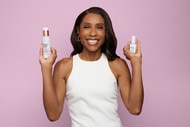
Create a free profile to get unlimited access to exclusive videos, sweepstakes, and more!
Everything You Wanted To Know About Acne, But Were Too Grossed Out To Ask
Get the 411 on cheek breakouts, the dreaded bacne, and more.

There’s one word for a pimple that’s so big it takes half a bottle of concealer to hide: annoying. But what if that obnoxious zit could be a sign of something else? What if it’s a sign of a larger health problem?
“Most people don't realize that skin is just a mirror reflection of what is going on inside the body or mind, in case of stress. Our skin was created to bring to our attention the internal problems which would otherwise be hard to notice,” says Dr. Svetlana Kogan, MD and author of Diet Slave No More!
Dr. Kogan incorporates Western and Eastern medical philosophies in her NYC practice, and she says that a patient’s skin condition can be a gauge of their overall health.
For example, breakouts or skin flare-ups could be a sign of diseases like systemic lupus erythematosus (SLE), psoriasis, Hashimoto's Thyroiditis, uncontrolled diabetes, gastroesophageal reflux disease (GERD), small intestine bacterial overgrowth and candidiasis—or even lifestyle problems like stress or lack of sleep.
Here’s what it might mean for your health if you’re always getting breakouts in a specific spot on your face.
Forehead: If your forehead is your trouble spot, it could be a sign of psoriasis (an autoimmune disease that causes red scaly patches on your skin), or seborrheic dermatitis (a red, itchy rash on your scalp).
Nose: Breakouts on your nose could be associated with rosacea, a skin condition that causes facial redness. Systemic lupus erythematosus and other autoimmune conditions can cause acne flareups on the sides of the nose and inner part of cheeks towards the nose.
Cheeks: Autoimmune issues and stress could be a factor for acne on your cheeks. The T-Zone (forehead, nose, and inner cheeks is the most common place for acne because that area produces the most the most sebaceous oil and it gets trapped in pores). “This worsens any pre-existing condition and makes acne much worse,” Dr. Kogan says.
Chin: Dr. Kogan says there’s nothing that hints at illnesses if you get acne on your chin. But, here’s what could be behind it: breakouts on the chin could mean a reaction to anything from waxing to a facial product, or even the wool on your sweater. Another issue that contributes to chin breakouts is the pressure of the hand supporting the chin or from constant touching of the chin.
Chest: Recurring acne on their chest could be a sign of autoimmune issues.
Back: Dr. Kogan says bacne is related to poor nutrition and stress.
Instead of just trying to cover up acne, consulting a doctor could help you get to the root of the problem. “There is always an internal imbalance which leads to acne formation,” says Dr. Kogan. “It could be a hormonal imbalance in a growing teenager, or it could be hypothyroidism, or vitamin D deficiency, or bacterial overgrowth in the gut, or a diet full of artificial preservatives and pesticides. Our skin always tells the truth about the way we have been treating our body, be it intentionally or unintentionally.”
Dr. Kogan spells out some lifestyle tweaks that can help combat skin troubles for healthy patients:
Eat organic food without preservatives and pesticides.
Cook at home most of the time. “Avoid restaurant food and alcohol: both are horrible for acne,” she says.
Use gentle make-up remover, without alcohol, to cleanse your skin without stripping it of its natural oils.
Use calendula-based toner to calm down inflammation twice a day. “You can even make it yourself from dry calendula flowers or tea bags,” says Dr. Kogan.
Get a good sleep. Destress periodically.
These are easier said than done—especially the destressing part!—but we just have to repeat to ourselves that clear skin would totally be worth skipping restaurant pizza and scheduling an early bedtime. Ugh.


























